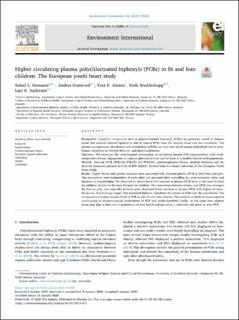| dc.contributor.author | Domazet, Sidsel Louise | |
| dc.contributor.author | Grøntved, Anders | |
| dc.contributor.author | Jensen, Tina Kold | |
| dc.contributor.author | Wedderkopp, Niels | |
| dc.contributor.author | Andersen, Lars Bo | |
| dc.date.accessioned | 2021-03-19T00:34:11Z | |
| dc.date.available | 2021-03-19T00:34:11Z | |
| dc.date.created | 2020-09-21T16:37:54Z | |
| dc.date.issued | 2020 | |
| dc.identifier.citation | Environment International. 2020, 136, Artikkel 105481. | en_US |
| dc.identifier.issn | 0160-4120 | |
| dc.identifier.uri | https://hdl.handle.net/11250/2734330 | |
| dc.description | This is an open access article under the CC BY-NC-ND license (http://creativecommons.org/licenses/BY-NC-ND/4.0/). | en_US |
| dc.description.abstract | Background: Lipophilic compounds such as polychlorinated biphenyls (PCBs) are primarily stored in adipose tissue, but exercise-induced lipolysis is able to release PCBs from the adipose tissue into the circulation. The plasma concentration, distribution and metabolism of PCBs can thus vary much among individuals due to inter-human variations in lifestyle behavior and pharmacokinetics.
Objectives: We examined the observational relationship of circulating plasma PCB concentrations with cardiorespiratory fitness, engagement in vigorous physical activity and fat mass in a healthy Danish child population.
Methods: Data on ∑PCB (PCB138, PCB153 and PCB180), cardiorespiratory fitness, skinfold thickness and objectively measured physical activity of 509 children derived from the Danish sub-study of The European Youth Heart Study.
Results: Higher fitness and greater leanness were associated with elevated plasma ∑PCB in both boys and girls. The associations were independent of each other and persisted after controlling for socio-economic status and duration of breastfeeding. We observed an almost three-fold increase in plasma ∑PCB level in the most fit/least fat children relative to the least fit/most fat children. The association between fatness and ∑PCB was strongest for boys as girls, and especially pubertal girls, displayed lower decrease in plasma ∑PCB with higher fat mass.
Discussion: Our findings suggest that increased lipolysis stimulates the release of PCBs into the vasculature. The consequence is higher plasma levels of PCB in very fit and lean subjects. This scenario is likely to cause negative confounding in epidemiological observations of PCB and cardio-metabolic health. At the same time adipose tissue may play a dual role in promoting adverse health and providing a relatively safe place to store PCB. | en_US |
| dc.language.iso | eng | en_US |
| dc.subject | epidemiology | en_US |
| dc.subject | cardiorespiratory fitness | en_US |
| dc.subject | persistent organic pollutants | en_US |
| dc.subject | toxicology | en_US |
| dc.subject | health | en_US |
| dc.subject | childhood | en_US |
| dc.title | Higher circulating plasma polychlorinated biphenyls (PCBs) in fit and lean children: The European youth heart study | en_US |
| dc.type | Peer reviewed | en_US |
| dc.type | Journal article | en_US |
| dc.description.version | publishedVersion | en_US |
| dc.rights.holder | © 2020 The Authors | en_US |
| dc.source.pagenumber | 8 | en_US |
| dc.source.volume | 136 | en_US |
| dc.source.journal | Environment International | en_US |
| dc.identifier.doi | 10.1016/j.envint.2020.105481 | |
| dc.identifier.cristin | 1831837 | |
| dc.description.localcode | Institutt for idrettsmedisinske fag / Department of Sports Medicine | en_US |
| dc.source.articlenumber | 105481 | en_US |
| cristin.ispublished | true | |
| cristin.fulltext | original | |
| cristin.qualitycode | 1 | |
